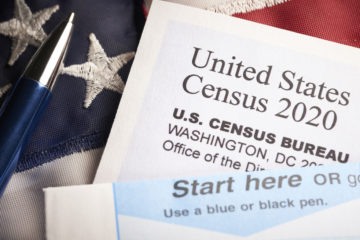
Politics and Science in Census Taking
The following excerpt is from the report “Politics and Science in Census Taking,” by Kenneth Prewitt, and published by the Russell Sage Foundation and the Population Reference Bureau. This report is one of several in the new series The American People, which sets the results of Census 2000 in context and collectively provides a portrait of the American people in a new century. Each report is written by an author or team of authors selected for their expertise with the data and their broad understanding of the implications of demographic trends. Reynolds Farley and John Haaga are the series editors.
A census is inevitably a blend of politics and science — politics because power and money are linked to how many people live where, science because the technically complex undertaking draws on many scientific disciplines.
The initial political purpose of the census is to adjust the regional distribution of power to match changes in the distribution of the population. With one exception, congressional seats have been reapportioned according to census results. Following the 1920 Census, Congress refused to reapportion. What produced that anomaly?
Between 1910 and 1920, there was a massive wartime population movement from the rural, Southern states to industrial Northern cities. In 1920, for the first time in American history, the census included more city dwellers than rural residents. An urban America was something new and disturbing, especially to those who held to the Jeffersonian belief that independent farmers best protected democracy. Among those of this persuasion were rural, conservative congressmen in the South and West. They saw that reapportionment would shift power to factory-based unions and politically radical immigrants concentrated in Northeastern cities. Conservatives in Congress blocked reapportionment, complaining among other things that because January 1 was then census day, transient agricultural workers were “incorrectly” counted in cities rather than on the farms to which they would return in time for spring planting. (Census day was later shifted to April 1, where it has remained.) The arguments dragged out for a decade, and Congress was not reapportioned until after the next census.
It is instructive to compare 1920 with the even more intense politics later in the century. The 1920 battle aligned the rural Southern and Western regions against the urban Northeast. These regional politics turned on whether to use the census results and were only incidentally about how the census was taken.
Recent controversies have not been regional but partisan, reflecting the sharp divide between Republicans and Democrats that now defines the political culture of America. And now, unlike earlier periods, census politics are focused on the science used to take the census.
These changes mark a significant turning point. For nearly 200 years, under bipartisan congressional oversight, census professionals had designed the methods by which data were collected and the results reported. If politicians sometimes argued about how the results would be applied, that was of no concern to the Census Bureau. Over time the bureau became a professional, scientific agency, careful to maintain distance from the partisan consequences of the statistics it generated. Its thousands of employees take for granted that it is the bureau’s reputation for nonpartisan, independent science that earns public cooperation and respect. To tarnish this reputation would put at risk data collection itself and would eventually lessen public confidence in census statistics.
How, then, did it come to pass that a technical and nonpartisan government agency was caught up in a sharply polarized partisan battle late in the 20th century?
Under-Representation a Growing Concern
The civil rights laws of the 1960s are an important part of the story. These laws were intended to guarantee equal opportunity to America’s racial minorities and to overcome a long history of racial discrimination. But conditions were slow to improve, and civil rights leaders in and out of government began to search for stronger policy instruments. Rather quickly in this effort, statistical proportionality became a favored legal and administrative tool. Statistical proportionality involves comparing how many members of a racial or ethnic minority group occupy particular positions compared with their numbers in the general population. If African Americans are 12 percent of the population, but only 5 percent of college entrants or only 1 percent of the nation’s business leaders, African Americans are under-represented. Under-representation is simply the ratio of the proportion of a group in a given position to its proportion in the general population. The denominator for this ratio comes from the basic population numbers of the census.
Under-representation became presumptive evidence of racial discrimination. In dozens of settings — higher education, health access, home mortgages, construction contracts — attention focused sharply on who was under-represented. The nation entered a period in which social justice politics became the calculation of proportionality, and these calculations moved into court cases, college admission practices, hiring and firing decisions, and government contracting. Racial minorities other than African Americans fell under the protection of civil rights laws. And soon women and the disabled made claims similar to those of racial minorities — that they were proportionately under-represented.
The civil rights influence on the politics of census taking was reinforced by a second if less dramatic government initiative of the late 1960s. The Republican administration of Richard Nixon believed that the legacy of New Deal policies and of World War II had shifted too much power to the federal government. It was time to rebalance by returning authority to state and local governments through revenue sharing. Taxes collected at the federal level would be shared with state and local governments, which would know better how to spend them. Health and education programs, public transportation initiatives, and many other state and local government activities began to receive federal funds in significant amounts.
The laws under which federal funds are distributed specify what groups and areas will receive them. Spending formulas routinely incorporate population size as a factor. Cities with more children in poverty receive greater school funds than cities with few such children; communities with large elderly populations receive more health care funds than communities with younger populations; faster-growing cities receive more transportation dollars than cities with declining populations. Although these formulas do not specify minorities, they often use measures — central city residence, crowded housing, low income — that correlate with race.
The political stage was set. The visionary social scientist, Daniel Patrick Moynihan, later to be senator from New York, was the guiding hand behind a “Conference on Social Statistics and the City” that drew out the obvious implication:
“Where a group defined by racial or ethnic terms and concentrated in special political jurisdictions is significantly undercounted in relation to other groups, individual members of that group are thereby deprived of the constitutional right to equal representation in the House of Representatives and, by inference, in other legislative bodies. They are also deprived of their entitlement to partake in federal and other programs designed for areas and populations with their characteristics. In other words, miscounting the population could unconstitutionally deny minorities political representation or protection under the Voting Rights Act. It could also deny local jurisdictions grant funds from federal programs.”1
These themes gathered political currency in the turbulent 1970s, putting pressure on the Census Bureau as it prepared for the 1980 Census. After all, the census was constitutionally established to ensure that political power and representation would be equitably allocated. Big-city mayors and civil rights leaders were fully aware that to count some groups more completely than others puts equal treatment at risk.
What should or could the bureau do about the increasingly unacceptable differential undercount? There were two possibilities: one, conduct a traditional census more effectively — that is, count better. This led the bureau to introduce a number of coverage improvement methods, including using more advertising to increase cooperation, hiring multilingual census takers who could reach out to hard-to-count population groups, and making multiple callbacks to nonresponding households. The reduction of the undercount from one census to the next gave some hope that the bureau could use traditional methods to count better. But the differential undercount between whites and blacks persisted.
Dual-System Estimation as a Fix
This left the second possibility: dual-system estimation. This statistical procedure held out the hope that the raw census counts could be adjusted to more accurately align them with the true size of different population groups. Specifically, and most important, it could correct differences in how well blacks were counted compared with whites. At least this was the hope.
In the 1980 Census, there was a post-enumeration survey designed to be used for dual-system estimation. The Census Bureau evaluated the results and concluded that there were problems that precluded statistically reliable adjustment. It announced that there would be no adjustment in the 1980 Census, but promised that it would continue its statistical work on dual-system estimation in anticipation of adjusting the next census.
This promise did not satisfy political interests that cared deeply about the rights of minorities, which they saw as denied by the undercount. More than 50 lawsuits were filed seeking to require the adjustment of the 1980 Census to compensate for missed minorities and city dwellers. The most serious legal challenge, brought by Detroit, New York City, and New York state, sought to stop the release of the 1980 Census results until they were adjusted. Under court order, the results were released on schedule, but the case was allowed to proceed to trial. A court ruling eventually upheld the Census Bureau’s decision because it had not acted in an “arbitrary and capricious” manner.2
During the 1980s, the bureau continued its statistical work, convinced that there was a good chance that adjustment methods could be improved and used in the 1990 Census. It planned accordingly.
One-Person, One-Vote and Careful Redistricting
By now, however, it was naïve to presume that census planning could be insulated from partisan politics. The Republican and Democratic parties were roughly balanced. Small changes in reapportionment and redistricting could decide which political party controlled the Congress or the White House. The one-person, one-vote ruling of the Supreme Court put pressure on the parties to squeeze every possible advantage in the redrawing of congressional districts after the 1990 Census. Increasingly sophisticated computer-assisted methods allowed the parties to make fine-grained decisions down to the block level.
In this strongly partisan environment, the Census Bureau announced in mid-decade that the 1990 Census would include a post-enumeration survey and that the raw census data would most likely be adjusted to minimize the differential undercount. The Commerce Department, which has formal authority over the Census Bureau, rejected the bureau’s plan. The department was quickly taken to court by a coalition of local governments and advocacy groups insisting that the plan be reinstated. There was an out-of-court settlement that allowed the Census Bureau to include a post-enumeration survey in the 1990 Census design, but then gave to the secretary of commerce the authority to set the criteria by which its results would be evaluated and to make the final decision about whether the raw census results would be adjusted.
Why did the Commerce Department try to stop its own bureau from designing the 1990 Census as it saw fit? Census politics had become partisan politics. By the time we got to the 1990 Census, it was obvious that among the population subgroups consistently undercounted were urban minorities, and the subgroups most likely to be overcounted were suburban whites. Leaders in the Democratic Party, understandably, wanted a census method that would increase urban populations in order to increase the number of districts likely to elect Democratic candidates. Eliminating the undercount would move in this direction. Republican Party strategists, also understandably, favored a traditional census, especially because it was known to work reasonably well in the white suburbs, where many of the Republican Party’s supporters were and are concentrated.
Partisan Interests Address Census Method
Census method had collided with partisan interests. Both sides dressed their arguments in high-minded language. Democrats spoke of fairness, not partisan advantage. They insisted that the Census Bureau be allowed to apply whatever scientific methods it thought would improve census accuracy. Republicans cited the constitutional provision that an “actual enumeration” be taken as reason to reject any plan using sampling, and they argued that there was no guarantee of a more accurate census using sampling and dual-system estimation. Both sides found support among reputable statisticians, though the weight of professional judgment favored the bureau’s design.
Leading up to the 1990 Census, it was a Republican secretary of commerce who tried but had been unable to stop the Census Bureau from including a post-enumeration sample survey. The subsequent out-of-court settlement then produced a curious directive. The bureau would execute the census, evaluate its work, and then decide whether adjustment would improve the raw count. But its decision would take the form of a recommendation to the secretary who had opposed the design in the first place. This set the stage for a confrontation — and that is what happened with the 1990 Census.
The Census Bureau’s statisticians concluded that dual-system estimation had worked well enough to warrant statistical adjustment. Barbara Bryant, director of the Census Bureau and a Republican appointee, agreed with this conclusion and presented her recommendation to Commerce Secretary Robert A. Mossbacher. He rejected the recommendation. Overruling a statistical agency in this way was unprecedented, as was one reason the secretary gave for his decision: “The choice of the adjustment method selected by the Census Bureau officials can make a difference in apportionment, and the political outcome of that choice can be known in advance. I am confident that political considerations played no role in the Census Bureau’s choice of an adjustment model for the 1990 Census. I am deeply concerned, however, that adjustment would open the door to political tampering with the census in the future.”3
This was the first time in U.S. history that a high government official voiced the charge that the nonpartisan, professionally managed Census Bureau might choose a data collection methodology in order to favor one political party over another. The secretary’s language was cautious, and he was careful to say that it could happen, not that it had, but in the highly charged political atmosphere cautionary language was soon forgotten. In the close presidential election of 1992, Arkansas Governor Bill Clinton defeated the incumbent Republican, George Bush. Republicans felt that an outsider, and an untrustworthy one at that, had captured the White House. Partisan polarization reached new highs in the 1994 congressional elections, which brought to Congress a number of conservative Republicans deeply mistrustful of Clinton. The Republican Party gained control of the House of Representatives in 1994, and kept control during the entire period in which the 2000 Census was being planned and conducted.
Census Design Also Targeted
As inevitable as it was unfortunate, census design became a target of partisan animosities. Statistical adjustment, often though inaccurately reduced to the label “sampling,” became a political football. The Democratic Party, with its control of the White House, had no doubt that the census could improve its political fortunes. Clinton’s first secretary of commerce was the popular African American, Ron Brown, who died in a plane crash, and was replaced by Bill Daley, son of renowned Chicago Mayor Richard Daley, remembered by Republicans as the party boss who had “stolen” the election that barely sent Kennedy to the White House three decades earlier. Republicans were deeply distrustful of what they saw as a very political Commerce Department, and certainly this department did forcefully protect the bureau’s right to prepare a 2000 Census that incorporated the adjustment methodology.
Congressional Republicans were now in control of the key subcommittees that reviewed the census plans and appropriated their funds. Their position was clear. In 1997, Jim Nicholson, chairman of the Republican National Committee, sent the following call to arms to local party leaders:
“I am contacting you to recruit your assistance in addressing an issue of unusual importance to the future of the Republican Party. At the heart of the matter is one of the federal government’s most fundamental constitutional functions: the United States census. At stake is our GOP majority in the House of Representatives, as well as partisan control of state legislatures nationwide. The Clinton administration is implementing a radical new way of taking the next census that effectively will add nearly four and one-half million Democrats to the nation’s population. This is the political outcome of a controversial executive decision to use a complex mathematical formula to estimate and ‘adjust’ the 2000 Census. … The GOP would suffer a negative effect in the partisan makeup of 24 congressional seats, 113 state senate seats, and 297 state house seats nationwide. … An adjusted census could provide Democrats the crucial edge needed to prevail in close contests to control several state legislative chambers.”4
This prediction of how many Republican seats would be “lost” was never documented or subjected to independent analysis. Most students of reapportionment and redistricting believe it is probably impossible a priori to calculate partisan shifts in legislatures resulting from a decennial census, and consider the predictions in this memo highly implausible. As Census Bureau director, I knew that there were far too many factors at work in the census to expect one particular statistical method to have consequences of the scope set forth in Mr. Nicholson’s memo.
Plausibility, however, was not the issue. If the Republicans thought sampling would hurt their interests, Democrats were just as certain that it would help theirs. Civil rights organizations argued in favor of the adjustment methodology, claiming that the Republican Party did not care about racial minorities and social justice. The Congressional Black Caucus — all Democrats — took up the census as a leading civil rights issue, and they were often joined by Hispanic and Asian members of Congress. Dozens of congressional votes taken on census issues in the 1990s split on party lines.
One hardly surprising consequence of this partisanship was an unprecedented layer of official oversight and ongoing scrutiny of the Census Bureau. It was in the oversight system that the two political parties, one with control of the Congress and the other with control of the White House, jockeyed for advantage. This back and forth, with the Census Bureau in the middle, was a major challenge that faced the bureau as it made final preparations for the 2000 Census.
Kenneth Prewitt is the Carnegie Professor of Public Affairs, School of International and Public Affairs, Columbia University. He was director of the U.S. Census Bureau from 1998 to 2001.
References
- David. M. Heer, ed., Conference on Social Statistics and the City, Washington, D.C., 1967 (Cambridge, MA: Joint Center for Urban Studies of the Massachusetts Institute of Technology and Harvard University, 1968): 11.
- Margo J. Anderson and Stephen Feinberg, Who Counts? The Politics of Census Taking in Contemporary America (New York: Russell Sage Foundation, 1999).
- Robert A. Mossbacher, “Decision of the Secretary of Commerce on Whether a Statistical Adjustment of the 1990 Census of Population and Housing Should Be Made for Coverage Deficiencies Resulting in an Overcount or Undercount of the Population,” Federal Register 56, no. 140 (July 22, 1991): 33583. The passage cited presents only one of the reasons presented by the secretary; other considerations were technical and operational.
- Jim Nicholson, memo dated May 20, 1997. The Census Bureau itself does not collect information on political party affiliation, does not conduct analysis of possible partisan outcomes, and took no position on the plausibility of Mr. Nicholson’s forecast.






